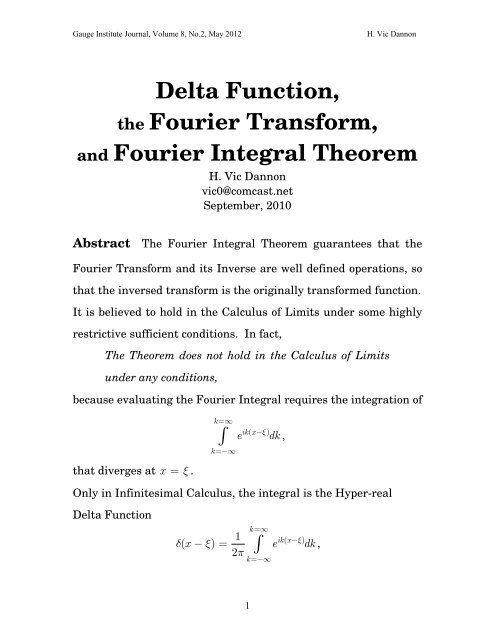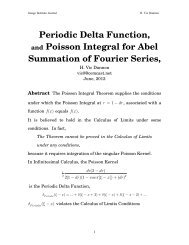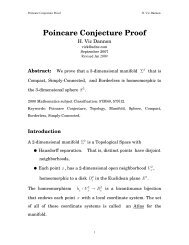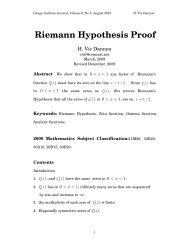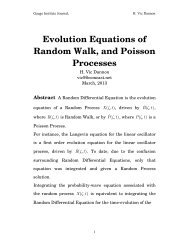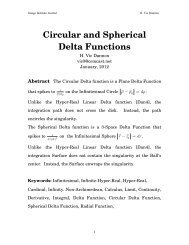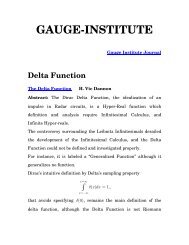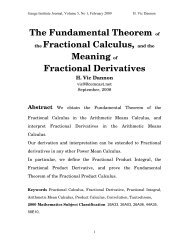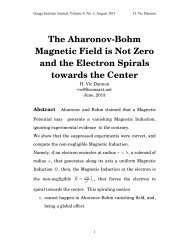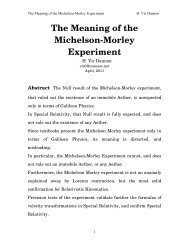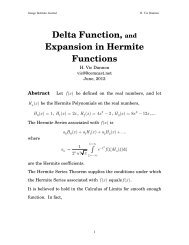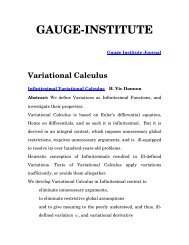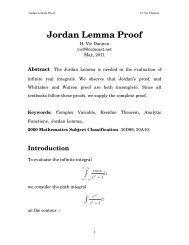Delta Function - Gauge-institute.org
Delta Function - Gauge-institute.org
Delta Function - Gauge-institute.org
Create successful ePaper yourself
Turn your PDF publications into a flip-book with our unique Google optimized e-Paper software.
<strong>Gauge</strong> Institute Journal, Volume 8, No.2, May 2012H. Vic DannonContentsIntroduction1. Hyper-real Line2. Integral of a Hyper-real <strong>Function</strong>3. <strong>Delta</strong> <strong>Function</strong>4. δ( x)and the Fourier Transform5. Fourier Integral Theorem6. Cosine representation of δ( x)and the Fourier integralTheorem7. δ(, xy)and the Fourier Transform8. δ(,,)xyz and the Fourier transform9. <strong>Delta</strong> Sequenceδn ( x )n⎛sin( nx)⎞= ⎜π ⎜⎝2nx ⎟⎠24
8RESUMOO presente trabalho tem como objetivo estudar a criação e aplicação das PolíticasPúblicas Educacionais em Minas Gerais, nos anos de 1996 a 2003.Partindo do pressuposto básico de que tais políticas influenciam diretamente otrabalho dos(as) docentes e o aproveitamento escolar dos(as) alunas, foi de sumaimportância verificar como as reformas educacionais são recebidas e aplicadas, ou não, nasinstituições públicas de ensino.O que aparece nos documentos e nos fatos oficiais não está em consonância com aprática, já que há uma enorme positividade nos discursos enquanto os recursos destinados àeducação pública são escassos e na maioria das vezes insuficientes para que as mudançassejam aplicadas com sucesso.Entendendo a ed ucação como uma política social voltada para a formação dacidadania, buscou-se a percepção de como as reformas elaboradas pelo Estado brasileiro,sobretudo em Minas Gerais, têm contribuído ou não para a formação de cidadãos ativos ecríticos perante à sociedade.Procurou-se, num segundo momento, entender como o <strong>org</strong>anismo sindical,representante dos(as) profissionais em educação, tem se colocado tanto diante das políticaseducacionais quanto das dificuldades sofridas por tais órgãos face às políticas neoliberaisinstituídas no Brasil a partir de princípios dos anos 80, entendendo-se, ainda, que oSindicato Único dos Trabalhadores em Educação do Estado de Minas Gerais participaefetivamente dos diversos momentos de ação político-sociais da história brasileira.Os impasses enfrentados pela educação brasileira são vários; e perceber as formasde enfrentamento ou as acomodações da comunidade escolar diante desses obstáculos foium dos principais desafios enfrentados neste trabalho.
<strong>Gauge</strong> Institute Journal, Volume 8, No.2, May 2012H. Vic Dannon15. In particular, there are no points on the real line thatcan be assigned uniquely to the infinitesimal hyper-reals, orto the infinite hyper-reals, or to the non-constant hyperreals.16. No neighbourhood of a hyper-real is homeomorphic toan nball. Therefore, the hyper-real line is not a manifold.17. The hyper-real line is totally ordered like a line, but itis not spanned by one element, and it is not one-dimensional.9
<strong>Gauge</strong> Institute Journal, Volume 8, No.2, May 2012H. Vic Dannon2.Integral of a Hyper-real <strong>Function</strong>In [Dan3], we defined the integral of a Hyper-real <strong>Function</strong>.Let f () x be a hyper-real function on the interval [ ab] , .The interval may not be bounded.f () x may take infinite hyper-real values, and need not bebounded.At eacha≤x≤b,there is a rectangle with basedx dx[ x − , x + 2], height f () x , and area2f ( xdx. )We form the Integration Sum of all the areas for the x ’s thatstart at x = a, and end at x = b,∑ f ( xdx ) .x∈[ a, b]If for any infinitesimal dx , the Integration Sum has the samehyper-real value, then f () x is integrable over the interval [ ab] , .Then, we call the Integration Sum the integral of f () x from x = a,to x= b, and denote it by10
<strong>Gauge</strong> Institute Journal, Volume 8, No.2, May 2012H. Vic Dannonx=b∫ f ( xdx ) .x=aIf the hyper-real is infinite, then it is the integral over [, ab] ,If the hyper-real is finite,x=b∫ fxdx ( ) = real part of the hyper-real . x=a2.1 The countability of the Integration SumIn [Dan1], we established the equality of all positive infinities:We proved that the number of the Natural Numbers,Card , equals the number of Real Numbers,2 Card Card = , andwe have2 Card2Card Card = ( Card) = .... = 2 = 2 = ... ≡ ∞.In particular, we demonstrated that the real numbers may bewell-ordered.Consequently, there are countably many real numbers in theinterval [ ab] , , and the Integration Sum has countably many terms.While we do not sequence the real numbers in the interval, thesummation takes place over countably many f ( xdx. )11
<strong>Gauge</strong> Institute Journal, Volume 8, No.2, May 2012H. Vic DannonThe Lower Integral is the Integration Sum where f ( x ) is replacedby its lowest value on each interval2.2∑x∈[ a, b]⎛⎜⎝dx dx2 2[ x − , x + ]⎞inf f ( t)dx⎠⎟x− ≤t≤ x+dx dx2 2The Upper Integral is the Integration Sum where f ( x ) is replacedby its largest value on each interval2.3∑x∈[ a, b]⎛⎜⎝dx dx2 2[ x − , x + ]⎞ sup f ( t)dx⎠⎟x− ≤t≤ x+dx dx2 2If the integral is a finite hyper-real, we have2.4 A hyper-real function has a finite integral if and only if itsupper integral and its lower integral are finite, and differ by aninfinitesimal.12
<strong>Gauge</strong> Institute Journal, Volume 8, No.2, May 2012H. Vic Dannon3.<strong>Delta</strong> <strong>Function</strong>In [Dan5], we have defined the <strong>Delta</strong> <strong>Function</strong>, and established itsproperties1. The <strong>Delta</strong> <strong>Function</strong> is a hyper-real function defined from thehyper-real line into the set of two hyper-reals⎧⎪ 1 ⎫⎨0, ⎪⎬⎪⎩dx⎭⎪ . Thehyper-real0 is the sequence 0, 0, 0,... . The infinite hyperreal1dxdepends on our choice of dx .2. We will usually choose the family of infinitesimals that isspanned by the sequences1n , 12n,1n3,… It is asemigroup with respect to vector addition, and includes allthe scalar multiples of the generating sequences that arenon-zero. That is, the family includes infinitesimals withnegative sign. Therefore,1dxwill mean the sequence n .Alternatively, we may choose the family spanned by thesequences12 n ,13 n ,14 n ,… Then, 1dxwill mean the13
<strong>Gauge</strong> Institute Journal, Volume 8, No.2, May 2012H. Vic Dannonsequence 2 n. Once we determined the basic infinitesimaldx , we will use it in the Infinite Riemann Sum that definesan Integral in Infinitesimal Calculus.3. The <strong>Delta</strong> <strong>Function</strong> is strictly smaller than ∞4. We define,1χ δ ( x) ≡ dx ( ),dx xdx⎡ ⎤ ,⎢−⎣ 2 2 ⎥⎦whereχ ⎡⎢−⎣dx,dx2 2⎧ dx dx1, x ∈ ⎡−, ⎤( x)= ⎪ ⎢ 2 2 ⎥⎨ ⎣ ⎦ .⎪⎪ 0, otherwise⎩⎤⎥⎦5. Hence, for x < 0 , δ ( x) = 0 at fordxx =− , δ( x)jumps from 0 to2dx dx⎢ ⎣,2 2 ⎥ ⎦ , 1( x)x ∈ ⎡−⎤δ = .dx1dx , at x = 0 ,δ (0) =1dx atdxx = , δ( x)drops from2 for x > 0 , δ ( x) = 0. xδ ( x) = 01dx to 0.6. If dx =1, ( x) = 1 1( x),2 1 1( x),3 1 1( x )...n[ − , ] [ − , ] [ − , ]δ χ χ χ2 2 4 4 6 67. If dx =2,n1 2 3δ ( x) = , , ,...2 2 22 cosh x 2 cosh 2x 2 cosh 3x14
<strong>Gauge</strong> Institute Journal, Volume 8, No.2, May 2012H. Vic Dannon8. If dx =1,n− x − 2x − 3x[0, ∞) [0, ∞) [0, ∞)δ( x) = e χ ,2 e χ , 3 e χ ,...x =∞∫9. δ( xdx ) = 1.x =−∞k =∞1 ik( x−ξ)10. δ( x − ξ)= e2π∫ dkk =−∞15
<strong>Gauge</strong> Institute Journal, Volume 8, No.2, May 2012H. Vic Dannon4.δ ( x)and the Fourier Transform4.1 F { x }δ ( ) = 1Proof:For any infinitesimal dx , the Integration Sum for thefunction−iωx 1 −iωx dx dxδ( xe ) = e χ[ − , ]dx2 2has only the unique hyper-real term1 −iωx[dx,dx −iωxe χ− ] dx = e χ[ −dx,dx].dx2 2 2 2Therefore, the Fourier Transformexists.F{ δ }x =∞−( x) = ∫ δ( x)e ωx =−∞i xdxSince−e − ] is bounded by 1, it is a finite hyper-real.i ω x dx dxχ[ ,2 2Therefore, the Fourier Transform equals to the constant part ofthis hyper-real.Since the constant hyper-real in[ − ,dx dx2 2] is zero, the constanthyper-real part of−e − ] isi ω x dx dxχ[ ,2 216
<strong>Gauge</strong> Institute Journal, Volume 8, No.2, May 2012H. Vic Dannoni ω 01e− = .That is{ x }F δ ( ) = 1.Consequently,4.2 δ( x)= the inverse Fourier Transform of the unit function 1ω=∞1=2π∫ν=∞ω=−∞e2πixiωxdω= ∫ e dν, ω = 2πνν=−∞Thus,4.312πω=∞∫ω=−∞eiωxdωx = 0=1 = an infinite hyper-realdxω=∞∫ω=−∞eiωxdωx ≠0=0Proof:1δ (0) = .dxδ( x) 0x≠ = . 170
<strong>Gauge</strong> Institute Journal, Volume 8, No.2, May 2012H. Vic Dannon5.Fourier Integral TheoremThe Fourier Integral Theorem is the Fundamental Theorem of theFourier Transform Theory.It guarantees that the Fourier Transform and its Inverse are welldefined operations, so that inversion yields the originallytransformed function.It is well known to hold in the Calculus of Limits under givenconditions.In fact, it does not hold in the Calculus of Limits under anyconditions.That failure is due to the inadequacy of the Calculus of Limits fordealing with singularities5.1 Fourier Integral Theorem does not hold in theCalculus of LimitsProof: By the Fourier Integral Theoremk =∞ ⎛ ξ=∞⎞1−ikξf ( x) = f( ξ)e ξ2πk =−∞ ⎜⎝ξ=−∞⎠⎟ikx∫ ∫ d e dk18
<strong>Gauge</strong> Institute Journal, Volume 8, No.2, May 2012H. Vic Dannon⎛⎞ ⎟= ⎜ ⎟⎝⎠ξ=∞ k =∞1 ik( x ξ)f () ξ ⎜−e dk∫ ξξ 2 π∫ d .=−∞ ⎜ k =−∞ ⎟However,xik( x−ξ)= ξ ⇒ e = 1,and the integral12πk =∞−ik( ξ−x)∫ e dk,k =−∞diverges.That is, the Fourier Integral Theorem cannot be written in theCalculus of Limits.Avoiding the singularity atξ = xdoes not recover the Theorem,because without the singularity the integral equals zero.Furthermore,5.2 Calculus of Limits Conditions are not sufficientfor the Fourier Integral TheoremProof: The Calculus of Limits Conditions are1. Piecewise Continuity of f ( x ), and f '( x ) in any boundedinterval.x =∞2. convergence of f ( x)dx∫x =−∞19
<strong>Gauge</strong> Institute Journal, Volume 8, No.2, May 2012H. Vic Dannon3. At a discontinuity point, f ( x ) is replaced by12( fx ( 0) fx ( 0) )+ + − .It is clear from 5.1 that even an infinitely differentiable f ( x ) willnot resolve the singularity of the <strong>Delta</strong> <strong>Function</strong>.In particular, the Calculus of Limits Conditions are not sufficientfor the Fourier Integral Theorem.In Infinitesimal Calculus, the Fourier Integral Theorem holds forany Hyper-Real function5.3 Fourier Integral Theorem for hyper-real f ( x )If f ( x ) is hyper-real function,Then, the Fourier Integral Theorem holds.k =∞ ⎛ ξ=∞⎞1−ikξf ( x) = f( ξ)e ξ2πk =−∞ ⎜⎝ξ=−∞⎠⎟ikx∫ ∫ d e dkProof:In Infinitesimal Calculus, the Integration Sumξ=∞∫ξ=−∞f ()( ξδx − ξ)dξyields f ( x ). That is,ξ=∞f ( x) = ∫ f( ξδ ) ( x −ξ)d ξ.ξ=−∞20
<strong>Gauge</strong> Institute Journal, Volume 8, No.2, May 2012H. Vic DannonSince <strong>Delta</strong> is the Inverse Fourier Transform of the function 1,δ(x− ξ ) equals the Integration Sumwhich vanishes at any x12πk =∞ik( x−ξ)∫ e dk,k =−∞≠ ξ , and equalsSubstituting in the Integration Sum for f ( x ),1dx at x = ξ .⎛ k⎞ ⎟f ( x) = f( ) ⎜ e d2⎟⎝⎠By changing the Summation order,ξ=∞ =∞1 ik( x ξ)ξ ⎜−∫ ξπ∫ k d .ξ=−∞⎜ k =−∞ ⎟k =∞ ⎛ ξ=∞⎞1−ikξikxf ( x) = f( ξ)e dξe dk2π.k =−∞ ⎜⎝ξ=−∞⎠⎟∫ ∫ Then, the Fourier transform of f ( x )x =∞−iαx∫ f ( xe ) dx,x =−∞converges to a hyper-real functionF( α)infinite hyper-reals, like the <strong>Delta</strong> <strong>Function</strong>.And the Inverse Fourier Transform of F( α)12πα=∞∫α=−∞−iαxF( α)e dα, some of its values may be21
<strong>Gauge</strong> Institute Journal, Volume 8, No.2, May 2012H. Vic Dannonconverges to the hyper-real function f ( x ).5.4 If f ( x ) is hyper-real function,Then,x =∞−iαx the hyper-real integral ∫ f ( xe ) dx converges to F( α)x =−∞α=∞ the hyper-real integral 1 iαxF( α)e d2π∫ α converges to f ( x )α=−∞The value of the Hyper-real Fourier Integral Theorem isdemonstrated by the following examples:5.5 The Hyper-real <strong>Delta</strong> δ( x)is not defined in the Calculus ofLimits, and is not Piecewise Continuous.δ'( x)is not defined, andis not Piecewise Continuous in any bounded interval.Butδ( x)satisfies the Hyper-real Fourier integral Theoremk =∞ ⎛ ξ=∞⎞1−ikξδ( x) = δ( ξ)eξ2πk =−∞ ⎜⎝ξ=−∞⎠⎟ikx∫ ∫ d e dkProof:By the sifting property of the Hyper-real <strong>Delta</strong>22
<strong>Gauge</strong> Institute Journal, Volume 8, No.2, May 2012H. Vic Dannonξ=∞−ikξ∫ δξ () e dξ=1.ξ=−∞Substituting this representation of 1 intoδ( x)k =∞1 ikx= e2π∫ dk ,k =−∞k =∞ ⎛ ξ=∞⎞1−ikξikxδ( x) = δ( ξ)e dξ e dk2π.k =−∞ ⎜⎝ξ=−∞⎠⎟∫ ∫ x =∞5.6 The Hyper-real f ( x) ≡ 1, does not satisfy ∫ fx ( ) dx
<strong>Gauge</strong> Institute Journal, Volume 8, No.2, May 2012H. Vic Dannon6.Cosine representation ofδ( x)andthe Fourier Integral Transform6.1 Cosine representation of <strong>Delta</strong>ω=∞1δ( x) = cos( ωx)π∫ dωω=0ν=∞= 2 ∫ cos(2 πνxd) νν=0Proof:ω=∞1( x)e i ωδ = x ω2π∫ dω=−∞⎧ 01ω= ω=∞⎫iωxiωx= ⎪⎨ e dω+ e dω⎪⎬2π∫ ∫⎪⎩ω=−∞ ω=0⎪⎭⎧1ω=∞ ω=∞⎫−iωxiωx= ⎪⎨ e dω+ e dω⎪⎬2π∫ ∫⎪⎩ω= 0 ω=0⎪⎭ω=∞1=π∫ω=0cos( ωxd) ω24
<strong>Gauge</strong> Institute Journal, Volume 8, No.2, May 2012H. Vic Dannon6.2 Cosine representation of the Fourier IntegralTheoremω=∞ ξ=∞1f ( x) = f( ξ)cos ω( x −ξ)ξπ∫ ∫ d dωω= 0 ξ=−∞ν=∞ ξ=∞∫ ∫ ν, ω = 2πν= 2 f ( ξ)cos2 πν( x −ξ)dξdξ=∞ν= 0 ξ=−∞Proof: f ( x) = f( ξδ ) ( x −ξ)d ξ∫ξ=−∞ξ=∞ ⎧ω=∞⎫1= f () ξ ⎪⎨ cos ω( x −ξ)d ⎪⎬dπξ=−∞ ⎪⎩ω=0⎪⎭∫ ∫ ω ξω=∞ ξ=∞= 1f ()cos ξ ω( x ξ)dξdωπ∫ ∫− .ω= 0 ξ=−∞25
<strong>Gauge</strong> Institute Journal, Volume 8, No.2, May 2012H. Vic Dannon7.δ (, xy)and the Fourier Transform7.1 2-Dimesional <strong>Delta</strong> <strong>Function</strong>δ⎛ ωx=∞ ⎞⎛ωy=∞ ⎞1 iω1ixxωyyxy = e dω⎟⎜⎟x ⎜ e dy2π∫ 2π∫ ω⎜ ⎝ ω =−∞ ⎠⎝ ⎟⎜ω =−∞ ⎠⎟( , )xy⎛ νx=∞ ⎞⎛νy=∞ ⎞2πνi2 ixxπνyy= e dν⎟⎜⎟x ⎜ e dνy,∫∫⎜ ⎝ ν =−∞ ⎠⎝ ⎟⎜ν =−∞ ⎠⎟xyωωxy==2πν2πνxy7.2 2-Dimesional Fourier TransformF{ }y=∞ x=∞−iωx−iωyx yf (, x y) f (, x y) e dxdy= ∫ ∫y=−∞x=−∞y=∞ x=∞− 2 πi( ν x+ν y)x y= ∫ ∫ f (, x y) e dxdy ,y=−∞x=−∞ωωxy==2πν2πνxy7.3 2-Dimesional Inverse Fourier Transform−1ωy=∞ ωx=∞1i( ωxx+ωyy)x y 2x y x y(2 π)ω =−∞ ω =−∞{ } = ∫ ∫F F( ω , ω ) F( ω , ω ) e dω d ωyx26
<strong>Gauge</strong> Institute Journal, Volume 8, No.2, May 2012H. Vic Dannonνyy=∞ ν =∞= ∫ ∫ν =−∞ ν =−∞xx2 πi( ν x+ν y)x y xx yF(2 πν , 2 πν ) e dν dνy,ωωxy==2πν2πνxy7.4 2-Dimesional Fourier Integral Theoremωy=∞ ωx=∞ ⎛ η=∞ ξ=∞⎞1−iωξ x− iωη y i( ωxx+ωyy)fxy (, ) = f(, ξη)e dd ξ η e dω 2 ∫ ∫ xdω(2 π)∫ ∫ω =−∞ ω =−∞⎜⎝η=−∞ ξ=−∞⎠⎟yxη=∞ ξ=∞ ⎛ ω1 x =∞⎞ ⎛ ωy=∞⎞iω( ) 1iy( y )(, )xx−ξω −η= ∫ ∫ f ξη e dω 2xdξ e dω 2yηπ∫ π∫ η=−∞ ξ=−∞ ⎜ d⎝ ω =−∞ ⎠⎟ ⎜⎝ ω =−∞⎠⎟xη=∞ ξ=∞ ⎛ ωx=∞⎞ ⎛ ωy=∞⎞2 πν i ( )2 iy( y )(, )xx−ξπν −η= f ξη e dν xdξ e dν ydηη=−∞ ξ=−∞ ⎜ ⎝ ω =−∞ ⎠⎟ ⎜⎝ω=−∞⎠⎟∫ ∫ ∫ ∫ ,xyyyωωxy==2πν2πνxy27
<strong>Gauge</strong> Institute Journal, Volume 8, No.2, May 2012H. Vic Dannon8.δ (,, xyz)and the Fourier Transform8.1 3-Dimesional <strong>Delta</strong> <strong>Function</strong>⎛ ωx=∞ ⎞⎛ωy=∞ ⎞⎛ωz=∞1 i 1 i 1yy( xyz , ,xx izz)xy2 e ωd 2 e ωd 2e ωδ = ω ωπ π πd ω⎜⎝ ω =−∞ ⎠⎟⎜⎝ω =−∞ ⎠⎟⎝⎜ω =−∞∫ ∫ ∫ zx y z⎞⎠⎟⎛ νν =∞x=∞ ⎞⎛y⎞⎛νz=∞πνπν2 i πνe dν2=xx iyye dν2 i ezzd∫⎜∫ ∫ ν⎝ν =−∞ ⎠⎟⎜⎝ν =−∞ ⎠⎟⎝⎜ν=−∞x y zx y z⎞,⎠⎟ωωωxyz= 2πν= 2πν= 2πνxyz8.2 3-Dimesional Fourier TransformF{ }z=∞ y=∞ x=∞−iω x−iω y−iωzx y zf (,, xyz) fxyze (,, ) dxdydz= ∫ ∫ ∫z=−∞ y=−∞ x=−∞z=∞ y=∞ x=∞− 2 πi( ν x+ ν y+ν z)x y z= ∫ ∫ ∫ f (,, x y z) edxdydz ,z=−∞ y=−∞ x=−∞ωωωxyz= 2πν= 2πν= 2πνxyz8.3 3-Dimesional Inverse Fourier Transform28
<strong>Gauge</strong> Institute Journal, Volume 8, No.2, May 2012H. Vic Dannon−1ωz=∞ ωy=∞ ωx=∞1i( ωxx+ ωyy+ωzz)x y z 3x y z x y z(2 π)ω =−∞ ω =−∞ ω =−∞{ } = ∫ ∫ ∫F F( ω , ω , ω ) F( ω , ω , ω ) edω dω dωz y xν =∞ ν =∞ ν =∞z= ∫ ∫ ∫yν =−∞ ν =−∞ ν =−∞z y xx2 πi( νxx+ νyy+νzz)F(2 πν ,2 πν ,2 πν ) e dν dν d ν ,x y z x yzωωωxyz= 2πν= 2πν= 2πνxyz8.4 3-Dimesional Fourier Integral Theoremωz=∞ ωy=∞ ωx=∞ ⎛ ζ=∞ η=∞ ξ=∞⎞1−iωξ x−iωη y−iωζzfxyz ( , , ) = f( ξηζ , , ) e ddd ξ ηζ3 ∫ ∫ ∫ ×(2 π)∫ ∫ ∫ω =−∞ ω =−∞ ω =−∞⎜⎝ζ=−∞ η=−∞ ξ=−∞⎠⎟z y xxi( ω x+ iω y+iωz)x y z× e d d dyω ω ωx y zζ=∞ η=∞ ξ=∞ ⎛ ω1 x =∞⎞ ⎛ ωy=∞⎞iω( ) 1iy( y )(, , )xx−ξω −η= ∫ ∫ ∫ f ξηζ e dω 2xdξ e dω 2yη×π∫ π∫ ζ=−∞ η=−∞ ξ=−∞ ⎜ d⎝ ω =−∞ ⎠⎟ ⎜⎝ ω =−∞⎠⎟⎛ ωz=∞⎞ 1iωz( z−ζ)e dω×⎜⎜zζ2π∫d⎜⎝ ω =−∞ ⎠⎟ζ=∞ η=∞ ξ=∞ ⎛ νx=∞⎞ ⎛ νy=∞⎞2 πν i ( )2 iy( y )( , , )xx−ξπν −η= ∫ ∫ ∫ f ξηζ e dν xdξ e dν ydη×∫ ∫ζ=−∞ η=−∞ ξ=−∞ ⎝⎜ ν =−∞ ⎠⎟ ⎜⎝ν=−∞⎠⎟xyz⎛ νz=∞⎞ 2 πν iz( z−ζ)e dν×⎜⎜zdζ∫ ,⎜⎝ν=−∞⎠⎟zωωωxyz= 2πν= 2πν= 2πνxyz29
<strong>Gauge</strong> Institute Journal, Volume 8, No.2, May 2012H. Vic Dannon9.<strong>Delta</strong> Sequenceδn ( x )n⎛sin( nx)⎞= ⎜π ⎜⎝ nx ⎠⎟2We show that the Hyper-real <strong>Delta</strong> <strong>Function</strong> is represented by the<strong>Delta</strong> Sequencesin( )n ( ) n⎛nx ⎞δ x = ⎜π ⎜⎝ nx ⎟⎠ .The n th component of the Hyper-real <strong>Delta</strong> is2n⎛sin( nx)⎞ ⎜. That is,π ⎜⎝ nx ⎠ ⎟2δ( x)n⎛sin( nx)⎞= ⎜π ⎜⎝ nx ⎠⎟2.9.1 Eachsin( )n ( ) n⎛nx ⎞δ x = ⎜π ⎜⎝ nx ⎟⎠• has the sifting property δ ( xdx ) = 1,2x =∞∫x =−∞• is a continuous Hyper-real function,n• peaks atx = 0 to1δ (0) = n .nπProof:30
<strong>Gauge</strong> Institute Journal, Volume 8, No.2, May 2012H. Vic Dannonx =∞ x =∞2 x =∞2n sin ( nx) 1 sin ( nx)δ ( xdx ) = dx=2 dx= 1.∫ ∫ ∫nπ2 2 2nx πnxx=−∞ x=−∞ x=012πn,by ⎡Spiegel2⎤⎣ ⎦To see that1δ (0) = n , we use the infinitesimal2nπ1n. Then,δ211 n⎛sin( ) ⎞ nn( ) = n2π⎜ 1⎜⎝ ⎟n ⎠.sin( ο)Since for any infinitesimal ο , = 1, we haveο1 nδ n( ) = ,n2πand1δ (0) = n .nπTherefore,9.2 The sequence represents the Hyper-real <strong>Delta</strong>2 2 2sin ( x) sin (2 x) sin (3 x)δ( x) = , , ,... .2 2 2πx 2πx 3πx9.3plots in Maple the 1000 th component, that peaks at 1000 318π ≈ .31
<strong>Gauge</strong> Institute Journal, Volume 8, No.2, May 2012H. Vic Dannon9.4plots in Maple the10 6component, that peaks at10 6318, 310π ≈ .32
<strong>Gauge</strong> Institute Journal, Volume 8, No.2, May 2012H. Vic DannonTo show the relation between the infinitesimal dx , and thisHyper-realδ( x), we note9.5 If dx is given byi n1= ,nThen This Hyper-real δ( x)Hpeaks to1.πdxHmay be written symbolically byδ( x)1⎛sin( x) ⎞ dx= πdx⎜⎜⎝ ⎠⎟xdx233
<strong>Gauge</strong> Institute Journal, Volume 8, No.2, May 2012H. Vic DannonReferences[Dan1] Dannon, H. Vic, “Well-Ordering of the Reals, Equality of all Infinities,and the Continuum Hypothesis” in <strong>Gauge</strong> Institute Journal Vol.6, No. 2, May2010;[Dan2] Dannon, H. Vic, “Infinitesimals” in <strong>Gauge</strong> Institute Journal Vol.6,No. 4, November 2010;[Dan3] Dannon, H. Vic, “Infinitesimal Calculus” in <strong>Gauge</strong> Institute JournalVol.7, No. 4, November 2011;[Dan4] Dannon, H. Vic, “Riemann’s Zeta <strong>Function</strong>: the Riemann HypothesisOrigin, the Factorization Error, and the Count of the Primes”, in <strong>Gauge</strong>Institute Journal of Math and Physics, Vol.5, No. 4, November 2009.A 2011 revision, published by the <strong>Gauge</strong> Institute, follows the development ofthe Infinitesimal Calculus [Dan3], that is necessary to establish Riemannresults.[Dan5] Dannon, H. Vic, “The <strong>Delta</strong> <strong>Function</strong>” in <strong>Gauge</strong> Institute JournalVol.8, No. 1, February 2012;[Riemann] Riemann, Bernhard, “On the Representation of a <strong>Function</strong> by aTrigonometric Series”.(1) In “Collected Papers, Bernhard Riemann”, translated fromthe 1892 edition by Roger Baker, Charles Christenson, andHenry Orde, Paper XII, Part 5, Conditions for the existence of adefinite integral, pages 231-232, Part 6, Special Cases, pages232-234. Kendrick press, 2004(2) In “God Created the Integers” Edited by Stephen Hawking,Part 5, and Part 6, pages 836-840, Running Press, 2005.34
<strong>Gauge</strong> Institute Journal, Volume 8, No.2, May 2012H. Vic Dannon[Spiegel1] Spiegel, Murray, “Fourier Analysis with applications to Boundaryvalue Problems” Schaum’s Outline Series, McGraw-Hill, 1974.p.80 has the sufficient conditions for the Fourier integral Theorem[Spiegel2] Spiegel, Murray, “Mathematical Handbook of Formulas andTables” Schaum’s Outline Series, McGraw-Hill, 1968. p. 96, #15.3635


